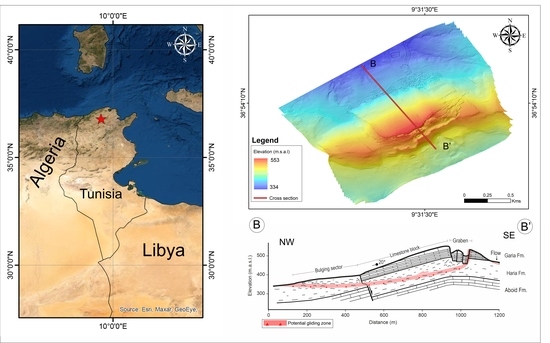Analysis of the Geological Controls and Kinematics of the Chgega Landslide (Mateur, Tunisia) Exploiting Photogrammetry and InSAR Technologies
Abstract
1. Introduction
2. Geological and Geomorphological Setting
3. Methodology
3.1. Terrain 3D Model Production
3.2. DInSAR Analysis
3.3. Geological Study Taking Advantage of Cutting-Edge Techniques
4. Results
4.1. Geomorphology and Classification of the Chgega Landslide
4.2. Relief Conditions for the Chgega Landslide Occurrence
4.3. Kinematics of the Chgega Landslide Derived from Open Joints
4.4. Estimated Velocity of Chgega Landslide by InSAR
5. Discussion
5.1. Relationship between Chgega Landslide and the Geological Structure
5.2. Motion Detected in Chgega and in Other Similar Landslide
5.3. Significance of the Chgega Landslide
6. Conclusions
Author Contributions
Funding
Data Availability Statement
Acknowledgments
Conflicts of Interest
References
- Aslan, G.; De Michele, M.; Raucoules, D.; Bernardie, S.; Cakir, Z. Transient motion of the largest landslide on earth, modulated by hydrological forces. Sci. Rep. 2021, 11, 1–12. [Google Scholar] [CrossRef]
- Gaidi, S.; Carmona, C.R.; Arnedo, J.P.G.; Pérez, J.V.; Melki, F.; Guillermo, B.R.; Jabaloy, A.; Marzougui, W.; Azañón, J.M. Paradigmatic Examples of Lateral Spreading Phenomena in the Betic-Rif and Maghrebian Chains. In Conference of the Arabian Journal of Geosciences; Springer: Cham, Switzerland, 2019; pp. 263–266. [Google Scholar] [CrossRef]
- Pasuto, A.; Soldati, M. 7.25 Lateral Spreading. Treatise Geomorphol. 2013, 7, 239–248. [Google Scholar] [CrossRef]
- Hungr, O.; Leroueil, S.; Picarelli, L. The Varnes classification of landslide types, an update. Landslides 2014, 11, 167–194. [Google Scholar] [CrossRef]
- Halliday, G.S.; McKelvey, R.J. Video-analysis of an extremely rapid rockslope failure, Nevis Bluff, New Zealand. In Landslides: Evaluation and Stabilization; Taylor & Francis Group: London, UK; 2004, pp. 1355–1360. Available online: http://old.geosolve.co.nz/assets/publication-articles/Video-analysis-of-an-extremely-rapid-rockslope-failure-Nevis-Bluff-New-Zealand.pdf (accessed on 28 August 2021).
- Lenart, J.; Pánek, T.; Dušek, R. Genesis, types and evolution of crevice-type caves in the flysch belt of the Western Carpathians (Czech Republic). Geomorphology 2014, 204, 459–476. [Google Scholar] [CrossRef]
- Pánek, T.; Hradecký, J.; Smolková, V.; Šilhán, K. Gigantic low-gradient landslides in the northern periphery of the Crimean Mountains (Ukraine). Geomorphology 2008, 95, 449–473. [Google Scholar] [CrossRef]
- Soldati, M.; Devoto, S.; Prampolini, M.; Pasuto, A. The spectacular landslide-controlled landscape of the northwestern coast of Malta. In Landscapes and Landforms of the Maltese Islands; Gauci, R., Schembri, J.A., Eds.; Springer: Cham, Switzerland, 2019; pp. 167–178. [Google Scholar]
- Devoto, S.; Hastewell, L.J.; Prampolini, M.; Furlani, S. Dataset of Gravity-Induced Landforms and Sinkholes of the Northeast Coast of Malta (Central Mediterranean Sea). Data 2021, 6, 81. [Google Scholar] [CrossRef]
- Di Maggio, C.; Madonia, G.; Vattano, M. Deep-seated gravitational slope deformations in western Sicily: Controlling factors, triggering mechanisms, and morphoevolutionary models. Geomorphology 2014, 208, 173–189. [Google Scholar] [CrossRef]
- Iotti, A.; Tarchiani, U. Notes on Some Lateral Spreading Phenomena around Roccalbegna-Mt.Labbro (Tuscany, Italy). Geogr. Fis. E Din. Quat. 1996, 19, 343–349. [Google Scholar]
- Fenton, C.; Martin, P.; Cheng, F.; Murphy, B. Geomorphological Analysis of Large Scale Slope Instability, Trotternish, Isle of Skye. In Engineering Geology for Society and Territory; Lollino, G., Giordan, D., Crosta, G.B., Corominas, J., Azzam, R., Wasowski, J., Sciarra, N., Eds.; Springer: Cham, Switzerland, 2015; Volume 2, pp. 1037–1040. [Google Scholar]
- Cooper, R.G. Mass movement caves in Great Britain. Stud. Speleol. 1983, 4, 37–44. [Google Scholar]
- Galve, J.P.; Carrión, M.; Carmona, C.R.; Gaidi, S.; Booth-Rea, G.; Sánchez, A.J.; Ruano, P.; Peña, J.V.P.; Hernández, J.M.A.; Melki, F. Formas del relieve generadas por fenómenos de expansión lateral y deslizamiento de bloques: De fortalezas naturales y lugares sagrados a valiosos recursos arqueológicos y paisajísticos. In Proceedings of the XV Reunión Nacional de Cuaternario Bizkaia Aretoa, Bilbao, Spain, 1–5 July 2019; pp. 406–409. [Google Scholar]
- Camafort, M.; Pérez-Peña, J.V.; Booth-Rea, G.; Melki, F.; Gràcia, E.; Azañón, J.M.; Galve, J.P.; Marzougui, W.; Gaidi, S.; Ranero, C.R. Active tectonics and drainage evolution in the Tunisian Atlas driven by interaction between crustal shortening and mantle dynamics. Geomorphology 2020, 351, 106954. [Google Scholar] [CrossRef]
- Cigna, F.; Banks, V.J.; Donald, A.W.; Donohue, S.; Graham, C.; Hughes, D.; McKinley, J.M.; Parker, K. Mapping ground instability in areas of geotechnical infrastructure using satellite InSAR and Small UAV surveying: A case study in Northern Ireland. Geosciences 2017, 7, 51. [Google Scholar] [CrossRef]
- Mateos, R.M.; Ezquerro, P.; Azañón, J.M.; Gelabert, B.; Herrera, G.; Fernández-Merodo, J.A.; Spizzichino, D.; Sarro, R.; García-Moreno, I.; Béjar-Pizarro, M. Coastal lateral spreading in the world heritage site of the Tramuntana Range (Majorca, Spain). The use of PSInSAR monitoring to identify vulnerability. Landslides 2018, 15, 797–809. [Google Scholar] [CrossRef]
- Martins, B.H.; Suzuki, M.; Yastika, P.E.; Shimizu, N. Ground Surface Deformation Detection in Complex Landslide Area—Bobonaro, Timor-Leste—Using SBAS DInSAR, UAV Photogrammetry, and Field Observations. Geosciences 2020, 10, 245. [Google Scholar] [CrossRef]
- Fonseca, A.F.d.P.S.C. Large Deep-Seated Landslides in the Northern Rif Mountains (Northern Morocco): Inventory and Analysis; Universidade de Lisbona 170. PhD diss. 2014. Available online: http://hdl.handle.net/10451/15604 (accessed on 1 March 2021).
- Beladam, O.; Balz, T.; Mohamadi, B.; Abdalhak, M. Using PS-InSAR with Sentinel-1 images for deformation monitoring in northeast Algeria. Geosciences 2019, 9, 315. [Google Scholar] [CrossRef]
- Laribi, A.; Walstra, J.; Ougrine, M.; Seridi, A.; Dechemi, N. Use of digital photogrammetry for the study of unstable slopes in urban areas: Case study of the El Biar landslide, Algiers. Eng. Geol. 2015, 187, 73–83. [Google Scholar] [CrossRef]
- Bounab, A.; El Kharim, Y.; El Hamdouni, R.; Hlila, R. A multidisciplinary approach to study slope instability in the Alboran Sea shoreline: Study of the Tamegaret deep-seated slow-moving landslide in Northern Morocco. J. Afr. Earth Sci. 2021, 184, 104345. [Google Scholar] [CrossRef]
- Frizon De Lamotte, D.F.; Saint Bezar, B.; Bracène, R.; Mercier, E. The two main steps of the atlas building and geodynamics of the Western Mediterranean. Tectonics 2000, 19, 740–761. [Google Scholar] [CrossRef]
- Khomsi, S.; Ghazi, M.; Jemia, B.; Frizon, D.; Lamotte, D.; Maherssi, C.; Echihi, O.; Mezni, R.; Ben Jemia, M.G.; de Lamotte, D.F.; et al. An overview of the Late Cretaceous–Eocene positive inversions and Oligo-Miocene subsidence events in the foreland of the Tunisian Atlas: Structural style and implications for the tectonic agenda of the Maghrebian Atlas system. Tectonophysics 2009, 475, 38–58. [Google Scholar] [CrossRef]
- DeCelles, P.G.; Giles, K.A. Foreland basin systems. Basin Res. 1996, 8, 105–123. [Google Scholar] [CrossRef]
- Babault, J.; Van Den Driessche, J.; Teixell, A. Longitudinal to transverse drainage network evolution in the High Atlas (Morocco): The role of tectonics. Tectonics 2012, 31, 1–15. [Google Scholar] [CrossRef]
- Melki, F.; Zouaghi, T.; Harrab, S.; Sainz, A.C.; Bédir, M.; Zargouni, F. Structuring and evolution of Neogene transcurrent basins in the Tellian foreland domain, north-eastern Tunisia. J. Geodyn. 2011, 52, 57–69. [Google Scholar] [CrossRef]
- Gaidi, S.; Booth-Rea, G.; Melki, F.; Marzougui, W.; Ruano, P.; Pérez-Peña, J.V.; Azañón, J.M.; Zargouni, F.; Chouaieb, H.; Galve, J.P. Active fault segmentation in Northern Tunisia. J. Struct. Geol. 2020, 139, 104146. [Google Scholar] [CrossRef]
- Burollet, P.F. Contribution à l’étude stratigraphique de la Tunisie centrale. Ann. Mines Géol. 1956, 18, 350. [Google Scholar]
- Rouvier, H. Gelogie de l’Extreme-Nord tunisien: Tectoniques et paleogeographies superposees a l’extremite orientale de la chaine nord-maghrebine. These Dr. Es Sc. Univ. Pierre Marie Curie. 1977. Available online: https://ci.nii.ac.jp/naid/20000798171 (accessed on 1 March 2021).
- Cohen, C.R.; Schamel, S.; Boyd-Kaygi, P. Neogene deformation in northern Tunisia: Origin of the eastern Atlas by microplate—Continental margin collision. Geol. Soc. Am. Bull. 1980, 91, 225–237. [Google Scholar] [CrossRef]
- Fournet, A.; Lajmi, T.; Pini, S. Carte géologique de la Tunisie au 1/50.000, la feuille n° 12 de Mateur. Off. Natl. Des Mines Tunis Tunisie. 1994. Available online: www.onm.nat.tn (accessed on 1 March 2021).
- Batik, P. Carte géologique de la Tunisie au 1/50.000, la feuille n° 11 de Hedhil. Off. Natl. Des Mines Tunis Tunisie. 1980. Available online: www.onm.nat.tn (accessed on 1 March 2021).
- Biely, A.; Maamouri, M.; Stranik, Z. Carte géologique de la Tunisie au 1/50.000, la feuille n° 18 de Beja. Off. Natl. Des Mines Tunis Tunisie. 1982. Available online: www.onm.nat.tn (accessed on 1 March 2021).
- Fournet, A.; Zargouni, F.; Burollet, P.F.; Dalmerac, B. Carte Géologique de la Tunisie au 1: 50 000, Feuille no 19, Tébourba éd. Serv. Géol., Tunis. 1999. Available online: www.onm.nat.tn (accessed on 1 March 2021).
- Mejri, L.; Regard, V.; Carretier, S.; Brusset, S.; Dlala, M. Evidence of Quaternary active folding near Utique (Northeast Tunisia) from tectonic observations and a seismic profile. Comptes Rendus—Geosci. 2010, 342, 864–872. [Google Scholar] [CrossRef]
- Bahrouni, N.; Bouaziz, S.; Soumaya, A.; Ben Ayed, N.; Attafi, K.; Houla, Y.; El Ghali, A.; Rebai, N. Neotectonic and seismotectonic investigation of seismically active regions in Tunisia: A multidisciplinary approach. J. Seismol. 2014, 18, 235–256. [Google Scholar] [CrossRef]
- Kharrat, S.; Harbi, A.; Meghraoui, M.; Bouaziz, S. The Tunisian Homogenized Macroseismic Database (Second Century–1981): First Investigations. Seismol. Res. Lett. 2018, 90, 347–357. [Google Scholar] [CrossRef]
- Soumaya, A.; Ben Ayed, N.; Khayati Ammar, H.; Tayech, M.; Ghanmi, M. Seismotectonic and seismic hazard map of Tunisia. In Proceedings of the AGU Fall Meeting Abstracts, San Francisco, CA, USA, 12–16 December 2016; Volume 2016, pp. T13A–2672. Available online: www.researchgate.net/publication/311740643_Seismotectonic_and_Seismic_Hazards_Map_of_Tunisia (accessed on 1 March 2021).
- Kujawski, H. Resultats de nouvelles observations a l’est des Hedil (Tunisie septentrionale). Bull. La Société Géologique Fr. 1967, 7, 735–740. [Google Scholar] [CrossRef]
- Marzougui, W.; Melki, F.; Arfaoui, M.; Houla, Y.; Zargouni, F. Major faults, salt structures and paleo-ridge at tectonic nodes in Northern Tunisia: Contribution of tectonics and gravity analysis. Arab. J. Geosci. 2014, 8, 7601–7617. [Google Scholar] [CrossRef]
- Atawa, M.; Boukerbout, H.; Zouaghi, T.; Mzali, H.; Saibi, H.; Abtout, A. Interpretation of gravity data using 3D inversion and 2D continuous wavelet transform in Hedil deformed structures, northern Tunisia. J. Afr. Earth Sci. 2019, 151, 371–390. [Google Scholar] [CrossRef]
- Booth-Rea, G.; Gaidi, S.; Melki, F.; Marzougui, W.; Azañón, J.M.; Zargouni, F.; Galvé, J.P.; Pérez-Peña, J. V Late Miocene Extensional Collapse of Northern Tunisia. Tectonics 2018, 37, 1626–1647. [Google Scholar] [CrossRef]
- Paskoff, R.; Sanlaville, P. Oscillations climatiques en Tunisie littorale depuis le dernier interglaciaire jusqu’au début de l’Holocène. Quaternaire 1986, 23, 78–83. [Google Scholar] [CrossRef]
- Leveau, P. Phénomènes météorologiques extrêmes et stratégies d’adaptation urbaine au Maghreb durant les premiers siècles de l’ère. In Var. environnementales, Mutat. Soc. nature, intensités, échelles temporalités des Chang. XXXIIe rencontres internationales d’archéologie et d’histoire d’Antibes Sous la direction; de Bertoncello, F., et Braemer, F., Eds.; Éditions APDCA: Antibes, France, 2012; pp. 221–232. [Google Scholar]
- Brun, A. Microflores et paléovégétations en Afrique du Nord depuis 30 000 ans. Bull. La Société Géologique Fr. 1989, 1, 25–33. [Google Scholar] [CrossRef]
- Ullman, S. The Interpretation of Visual Motion; Massachusetts Institute of Technology Pr: Oxford, UK, 1979; ISBN 026221007X. [Google Scholar]
- Seitz, S.M.; Curless, B.; Diebel, J.; Scharstein, D.; Szeliski, R. A comparison and evaluation of multi-view stereo reconstruction algorithms. In Proceedings of the 2006 IEEE Computer Society Conference on Computer Vision and Pattern Recognition (CVPR’06), Washington, DC, USA, IEEE; 2006; Volume 1, pp. 519–528. [Google Scholar] [CrossRef]
- Lowe, D.G. Object recognition from local scale-invariant features. In Proceedings of the Seventh IEEE International Conference on Computer Vision, IEEE; 1999; Volume 2, pp. 1150–1157. [Google Scholar] [CrossRef]
- Semyonov, D. Algorithms used in photoscan. In Proceedings of the Agisoft PhotoScan Forum; 2011; Volume 3. Available online: www.agisoft.com/forum/index.php?topic=89.0 (accessed on 1 March 2021).
- Casu, F.; Elefante, S.; Imperatore, P.; Zinno, I.; Manunta, M.; De Luca, C.; Lanari, R. SBAS-DInSAR parallel processing for deformation time-series computation. IEEE J. Sel. Top. Appl. Earth Obs. Remote Sens. 2014, 7, 3285–3296. [Google Scholar] [CrossRef]
- De Luca, C.; Cuccu, R.; Elefante, S.; Zinno, I.; Manunta, M.; Casola, V.; Rivolta, G.; Lanari, R.; Casu, F. An on-demand web tool for the unsupervised retrieval of earth’s surface deformation from SAR data: The P-SBAS service within the ESA G-POD environment. Remote Sens. 2015, 7, 15630–15650. [Google Scholar] [CrossRef]
- Manunta, M.; De Luca, C.; Zinno, I.; Casu, F.; Manzo, M.; Bonano, M.; Fusco, A.; Pepe, A.; Onorato, G.; Berardino, P. The parallel SBAS approach for sentinel-1 interferometric wide swath deformation time-series generation: Algorithm description and products quality assessment. IEEE Trans. Geosci. Remote Sens. 2019, 57, 6259–6281. [Google Scholar] [CrossRef]
- Notti, D.; Herrera, G.; Bianchini, S.; Meisina, C.; García-Davalillo, J.C.; Zucca, F. A methodology for improving landslide PSI data analysis. Int. J. Remote Sens. 2014, 35, 2186–2214. [Google Scholar] [CrossRef]
- Thiele, S.T.; Grose, L.; Samsu, A.; Micklethwaite, S.; Vollgger, S.A.; Cruden, A.R. Rapid, semi-automatic fracture and contact mapping for point clouds, images and geophysical data. Solid Earth 2017, 8, 1241–1253. [Google Scholar] [CrossRef]
- Erraioui, L. Environnements Sédimentaires Et Géochimie Des Séries De l’Eocène Du Nord-Est De La Tunisie, Tunis (Tunisia); Thése de doctorat de spécialité, Université Tunis II, 1994; 244p. [Google Scholar]
- Redhaounia, B.; Aktarakçi, H.; Ilondo, B.O.; Gabtni, H.; Khomsi, S.; Bédir, M. Hydro-geophysical interpretation of fractured and karstified limestones reservoirs: A case study from Amdoun region (NW Tunisia) using electrical resistivity tomography, digital elevation model (DEM) and hydro-geochemical approaches. J. Afr. Earth Sci. 2015, 112, 328–338. [Google Scholar] [CrossRef]
- Soldati, M. Deep-Seated Gravitational Slope Deformation. In Encyclopedia of Natural Hazards; Bobrowsky, P.T., Ed.; Springer: Dordrecht, The Netherlands, 2013; pp. 151–155. [Google Scholar]
- Pasuto, A.; Soldati, M. Rock Spreading. In Landslide Recognition: Identification, Movement and Courses; Dikau, R., Brunsden, D., Schrott, L., Ibsen, M.-L., Eds.; Wiley: Chichester, England, 1996; Pubblication No. 5; pp. 122–136. [Google Scholar]
- Ibsen, M.-L.; Brunsden, D.; Bromhead, E.; Collison, A. Block Slide. In Landslide Recognition: Identification, Movement and Courses; Dikau, R., Brunsden, D., Schrott, L., Ibsen, M.-L., Eds.; Wiley: Chichester, England, 1996; Pubblication No. 5; pp. 64–77. [Google Scholar]
- Bejaoui, H.; Aïfa, T.; Melki, F.; Zargouni, F. Structural evolution of Cenozoic basins in northeastern Tunisia, in response to sinistral strike-slip movement on the El Alia-Teboursouk Fault. J. Afr. Earth Sci. 2017, 134, 174–197. [Google Scholar] [CrossRef]
- Crosta, G.B.; Frattini, P.; Agliardi, F. Deep seated gravitational slope deformations in the European Alps. Tectonophysics 2013, 605, 13–33. [Google Scholar] [CrossRef]
- Delgado, J.; Vicente, F.; García-Tortosa, F.; Alfaro, P.; Estévez, A.; Lopez-Sanchez, J.M.; Tomás, R.; Mallorquí, J.J. A deep seated compound rotational rockslide and rock spread in SE Spain: Structural control and DInSAR monitoring. Geomorphology 2011, 129, 252–262. [Google Scholar] [CrossRef]
- Mantovani, M.; Devoto, S.; Forte, E.; Mocnik, A.; Pasuto, A.; Piacentini, D.; Soldati, M. A multidisciplinary approach for rock spreading and block sliding investigation in the north-western coast of Malta. Landslides 2013, 10, 611–622. [Google Scholar] [CrossRef]
- Mantovani, M.; Devoto, S.; Piacentini, D.; Prampolini, M.; Soldati, M.; Pasuto, A. Advanced SAR interferometric analysis to support geomorphological interpretation of slow-moving coastal landslides (Malta, Mediterranean Sea). Remote Sens. 2016, 8, 443. [Google Scholar] [CrossRef]
- Devoto, S.; Macovaz, V.; Mantovani, M.; Soldati, M.; Furlani, S. Advantages of using UAV digital photogrammetry in the study of slow-moving coastal landslides. Remote Sens. 2020, 12, 3566. [Google Scholar] [CrossRef]
- Gutiérrez, F.; Ortuño, M.; Lucha, P.; Guerrero, J.; Acosta, E.; Coratza, P.; Piacentini, D.; Soldati, M. Late Quaternary Episodic Displacement on a Sackung Scarp in the Central Spanish Pyrenees. Secondary Paleoseismic Evidence? Geodin. Acta 2008, 21, 187–202. [Google Scholar] [CrossRef][Green Version]
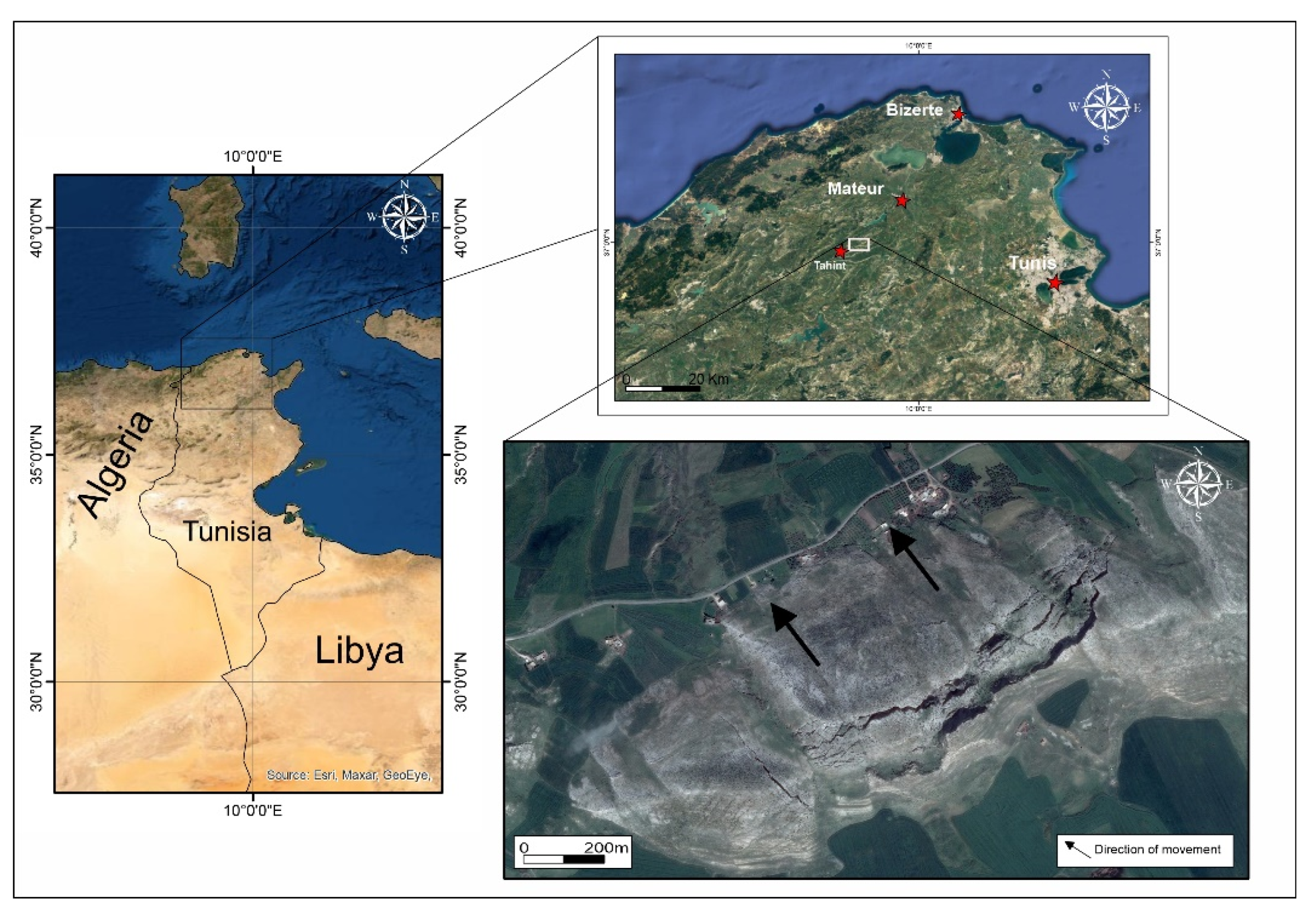
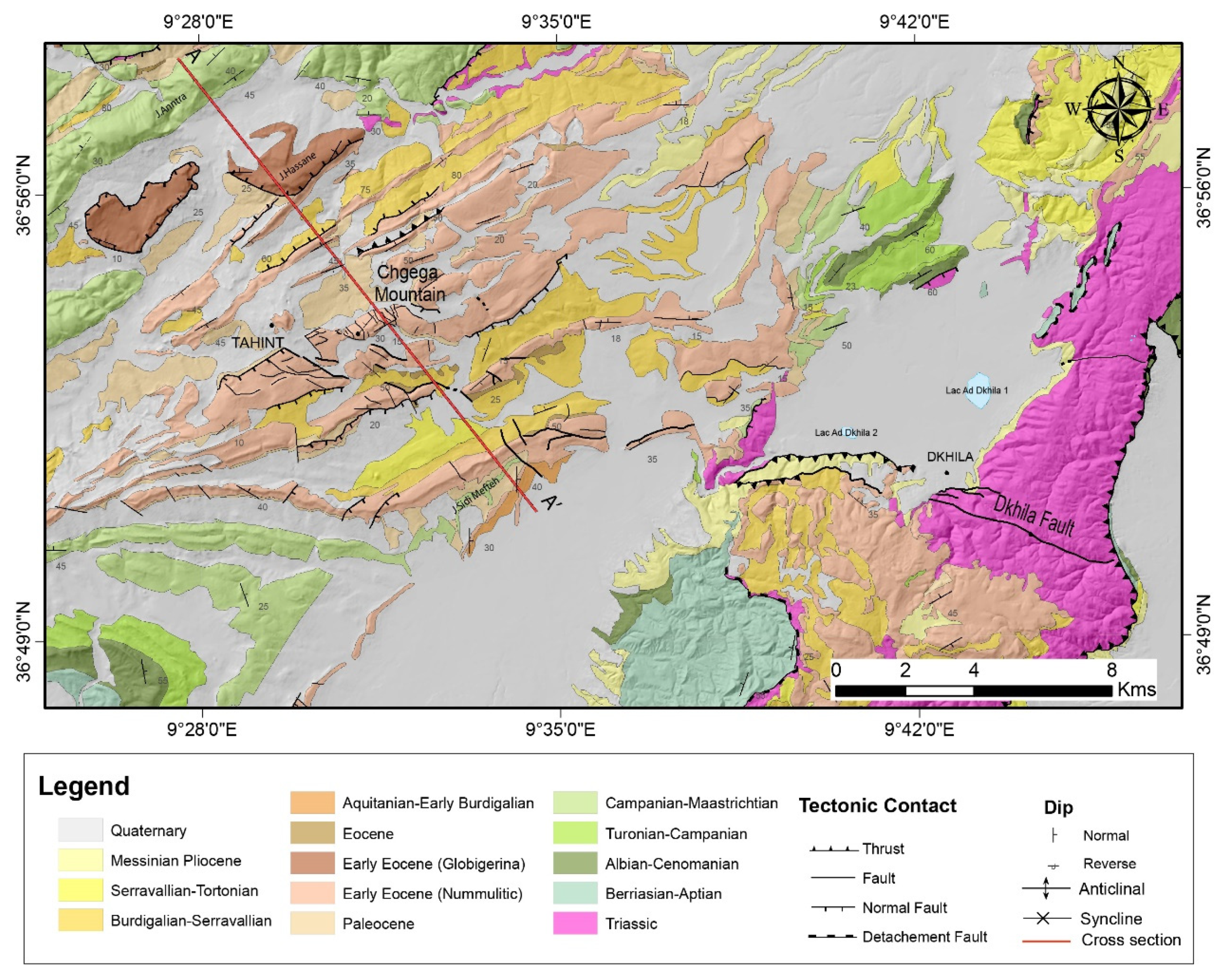
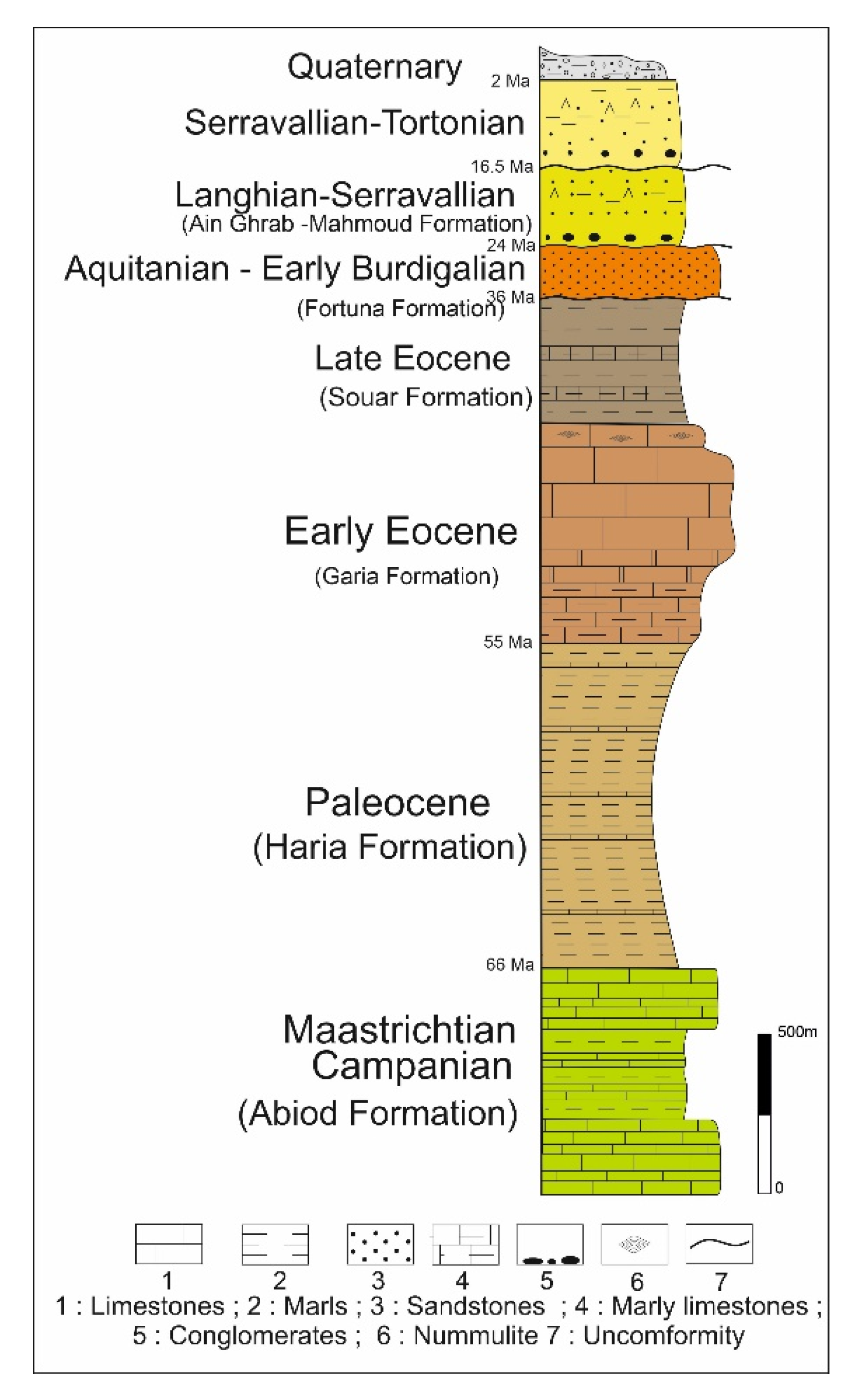

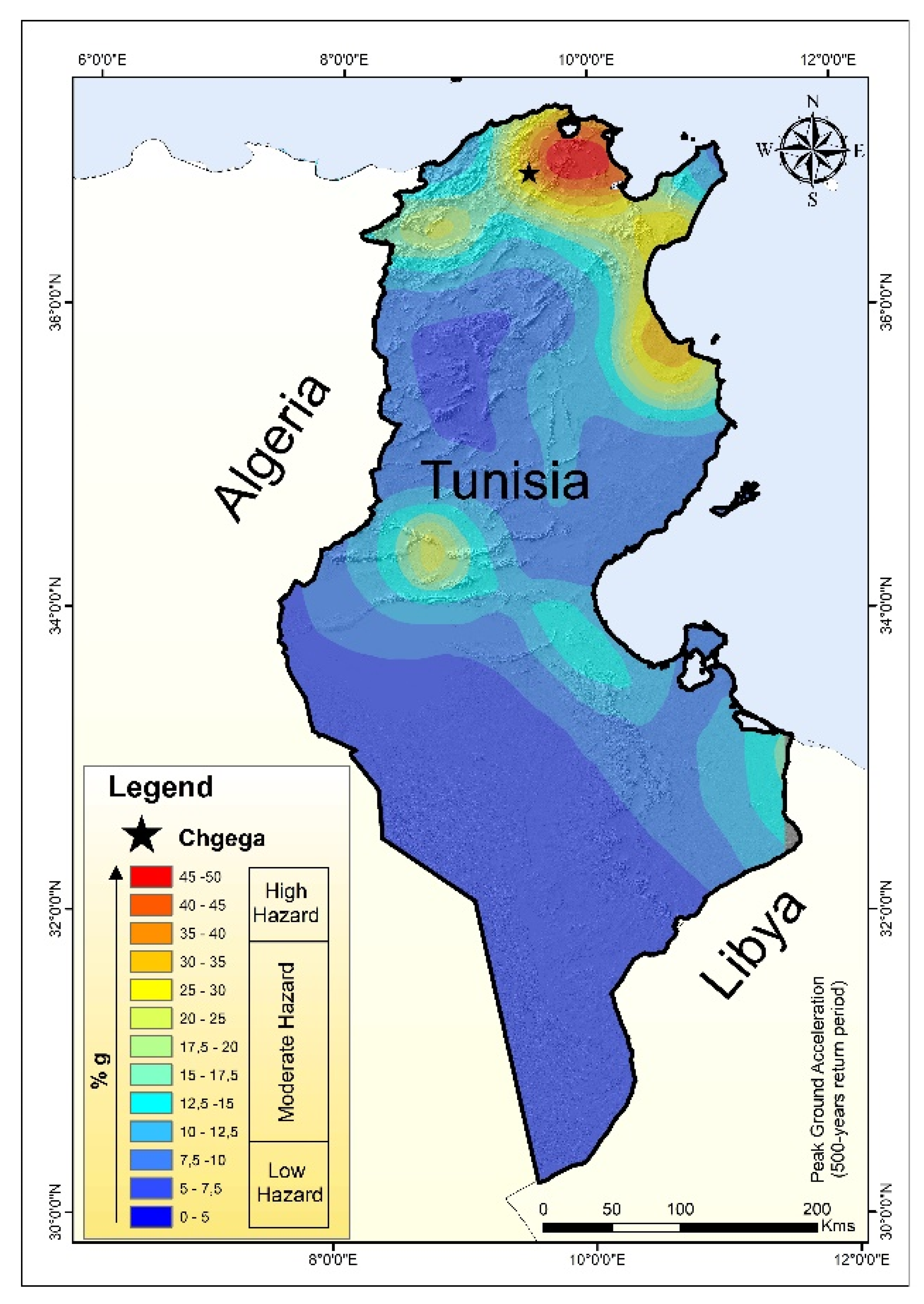
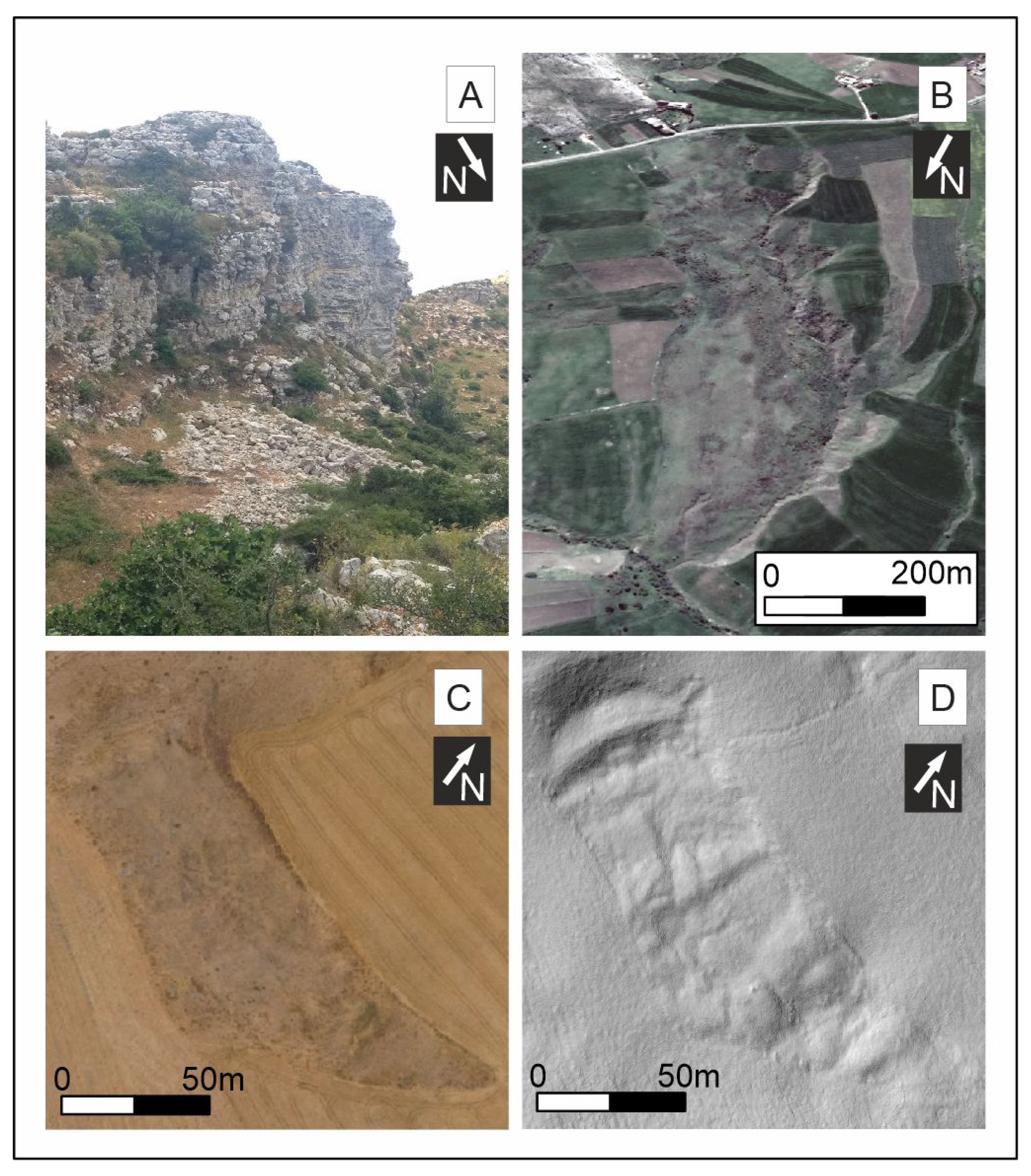
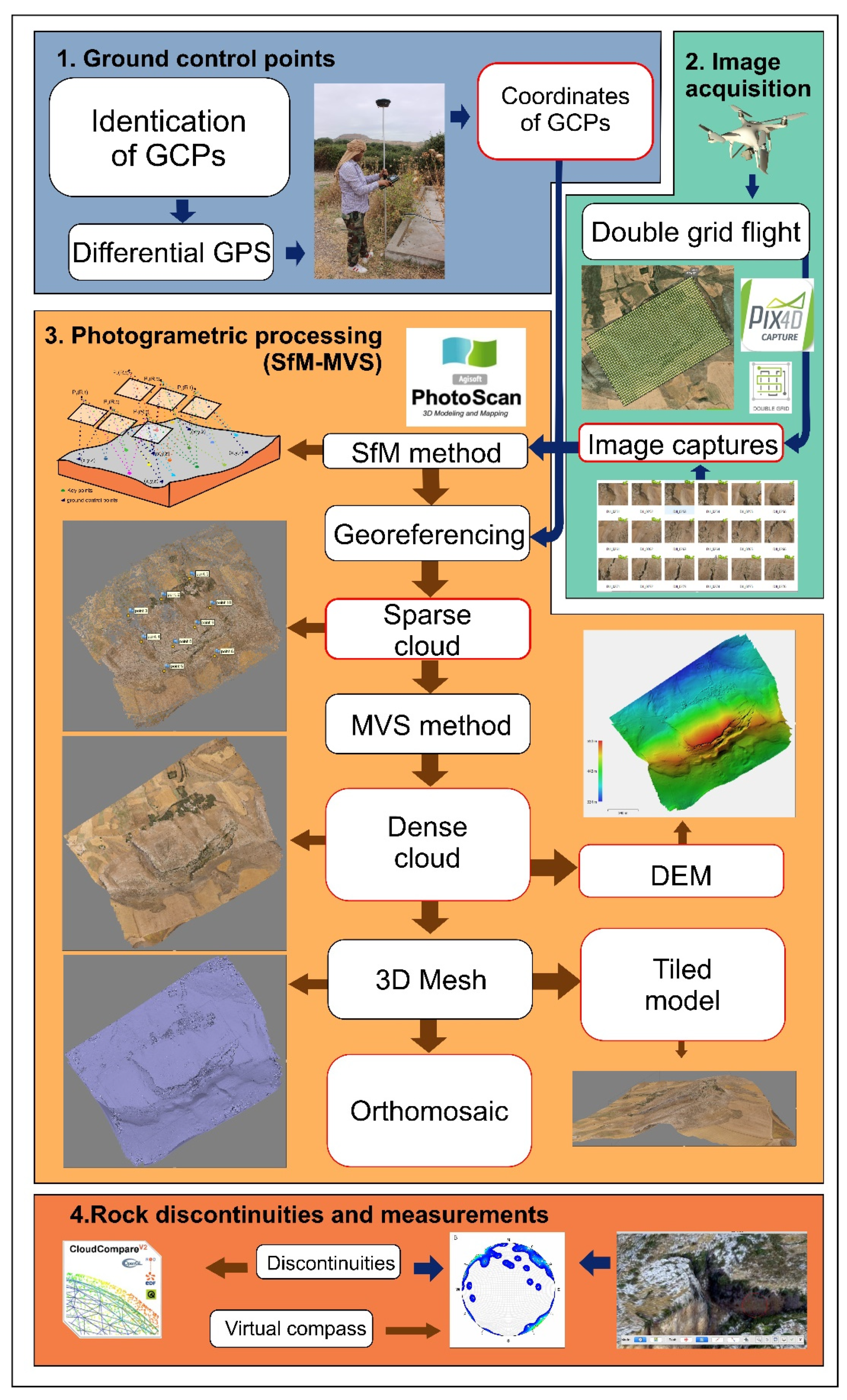
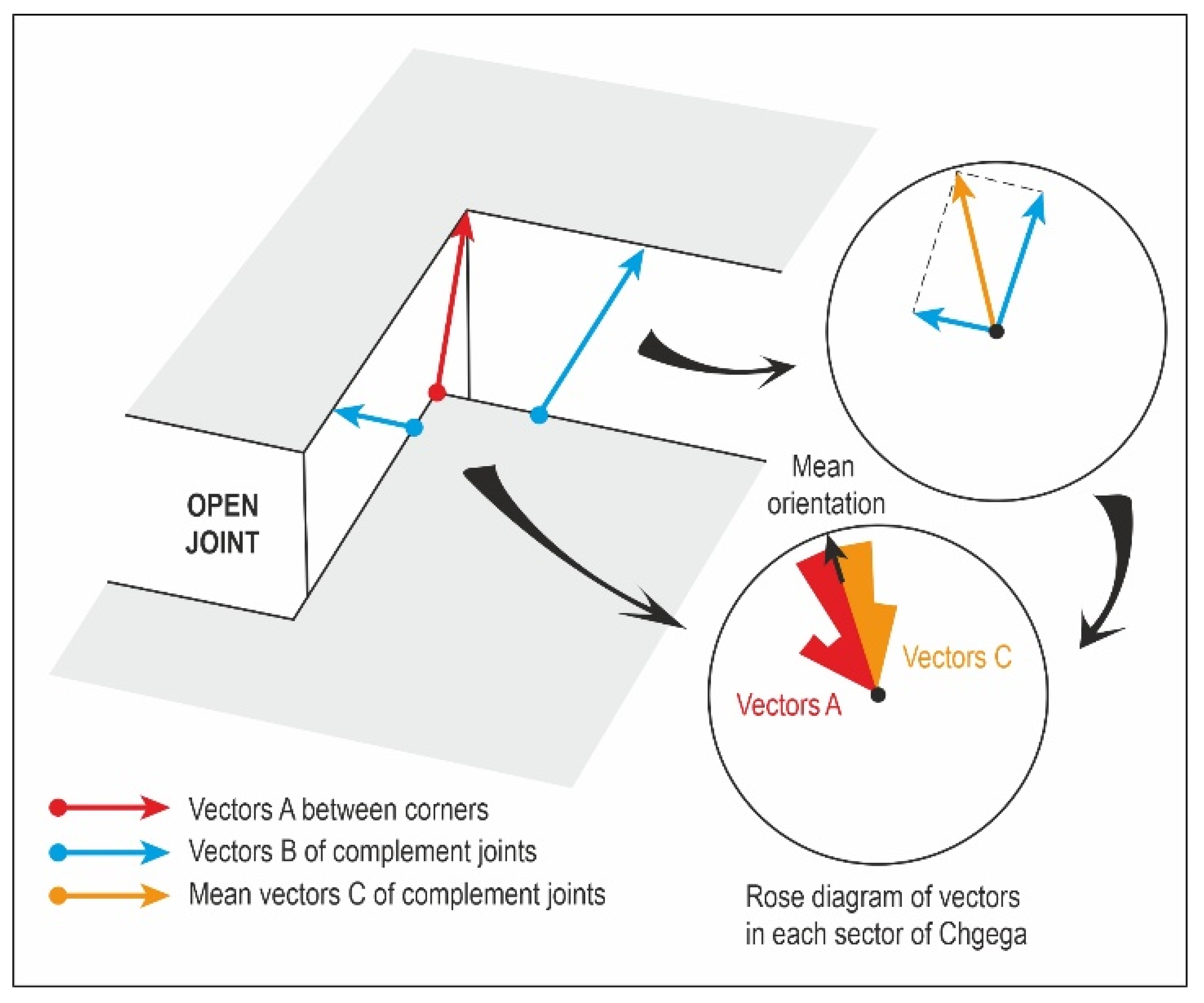
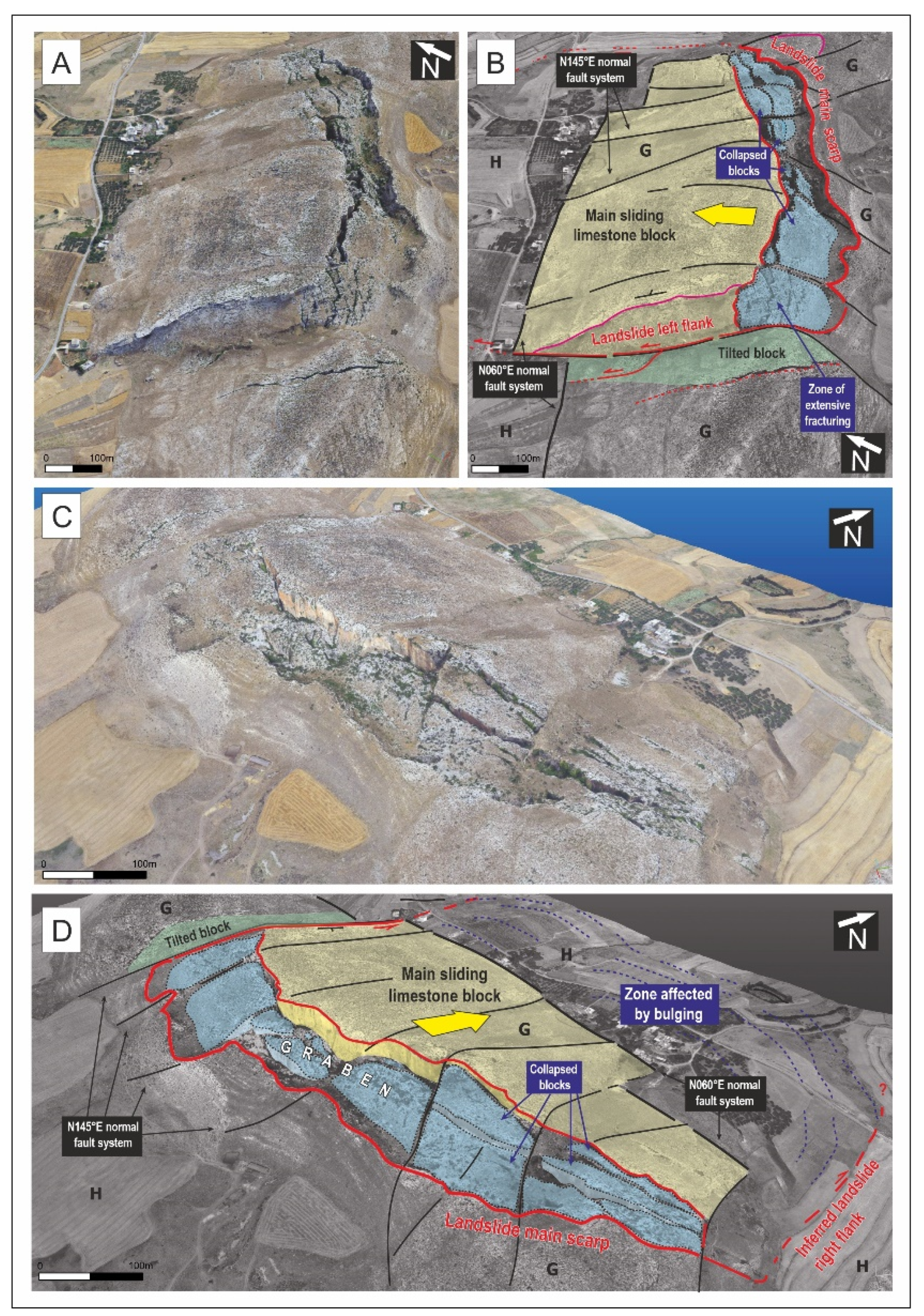
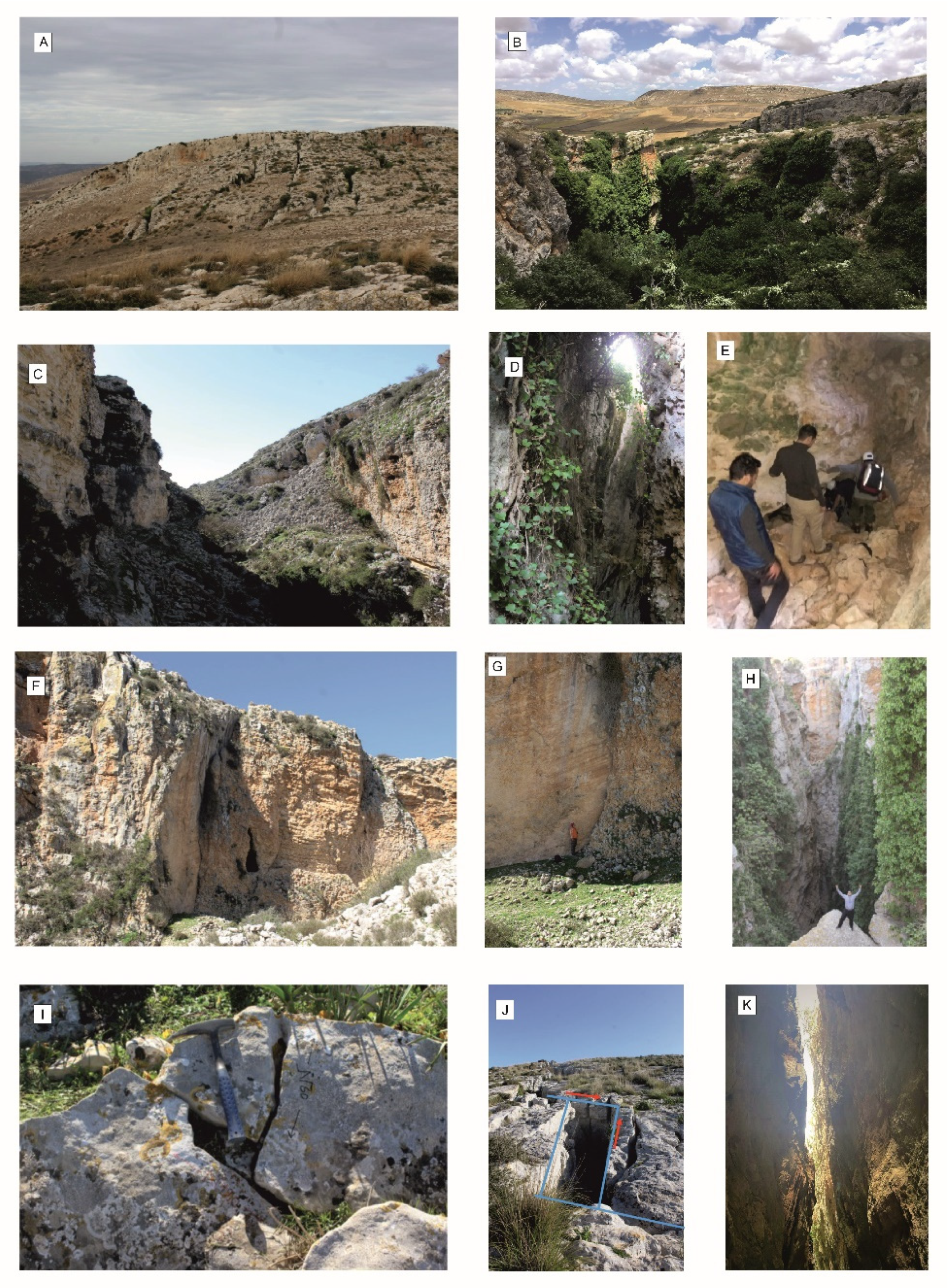
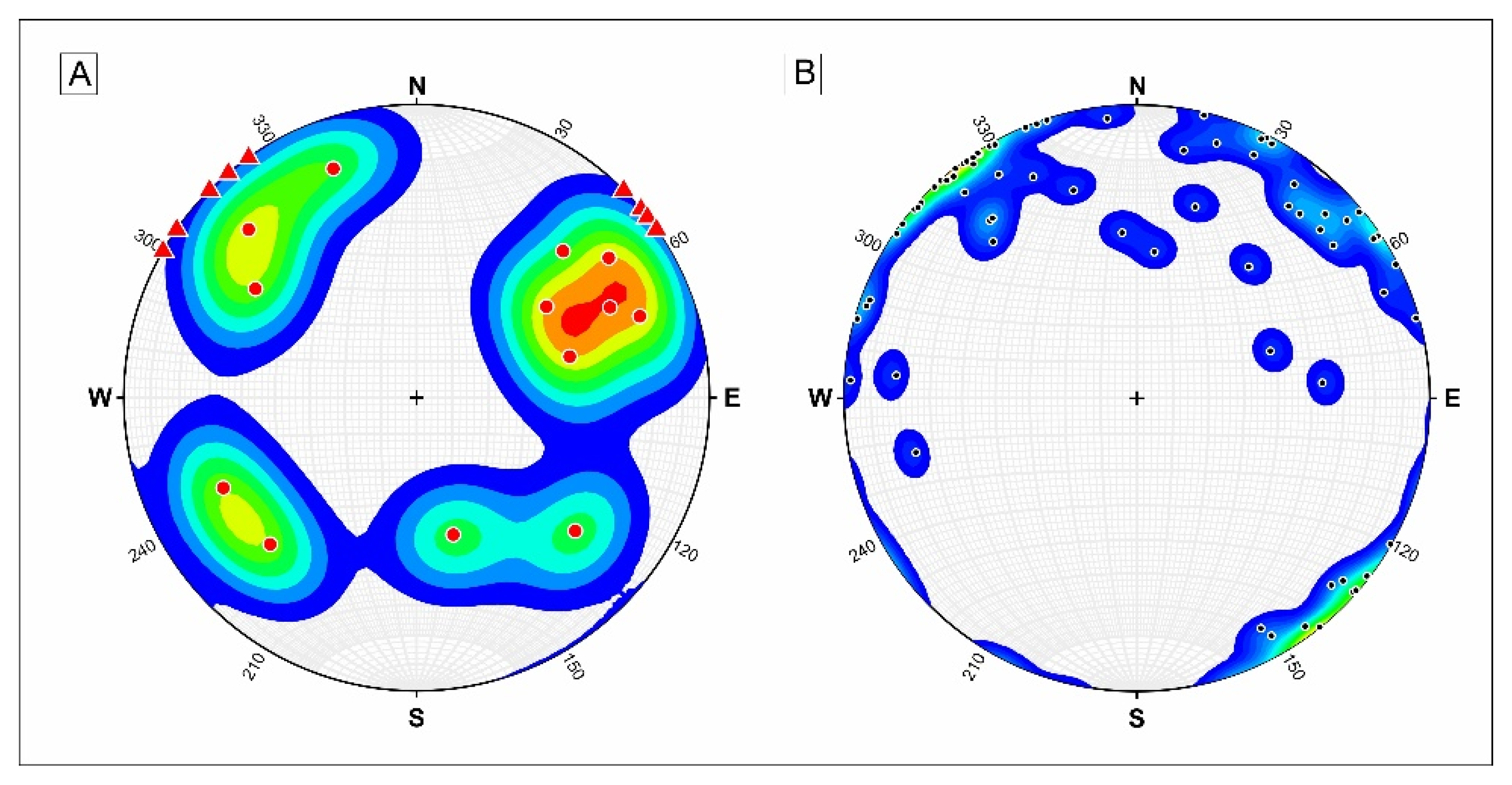
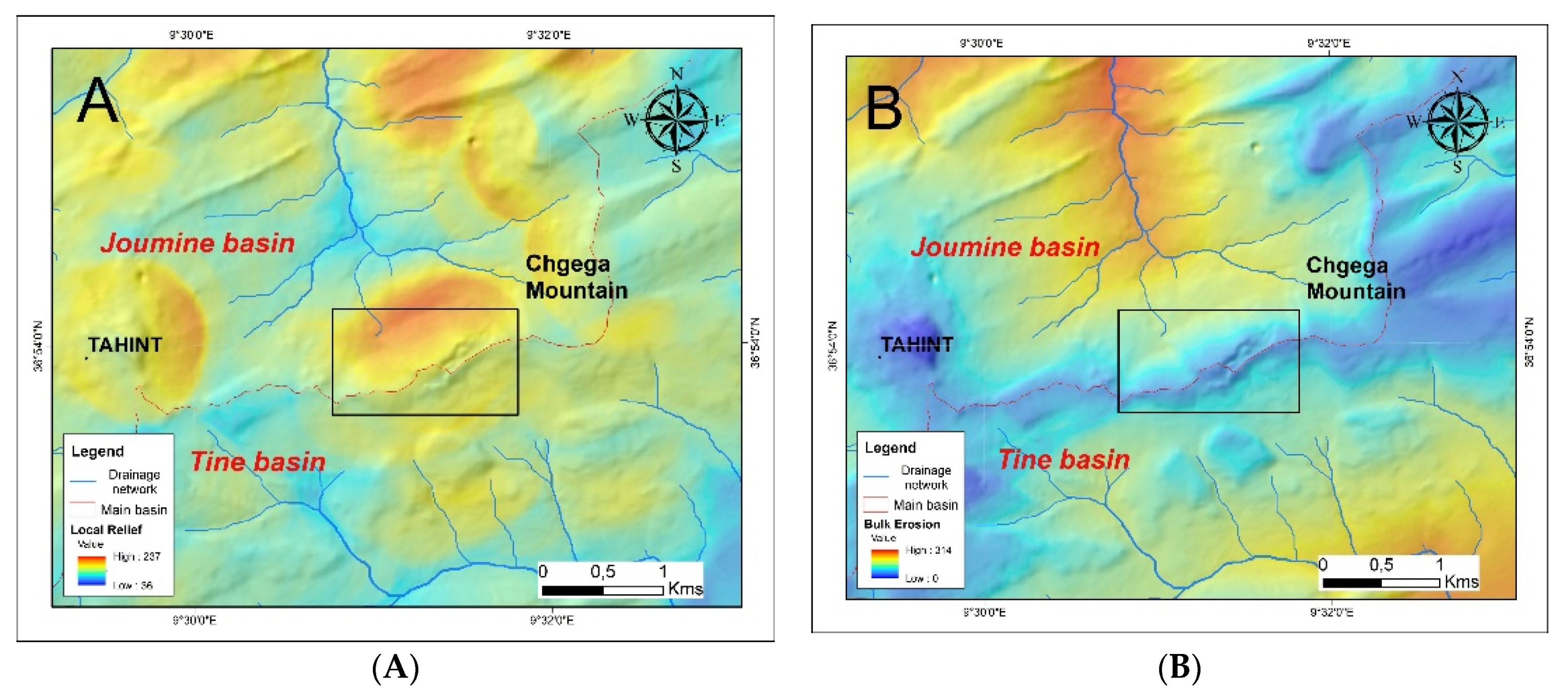
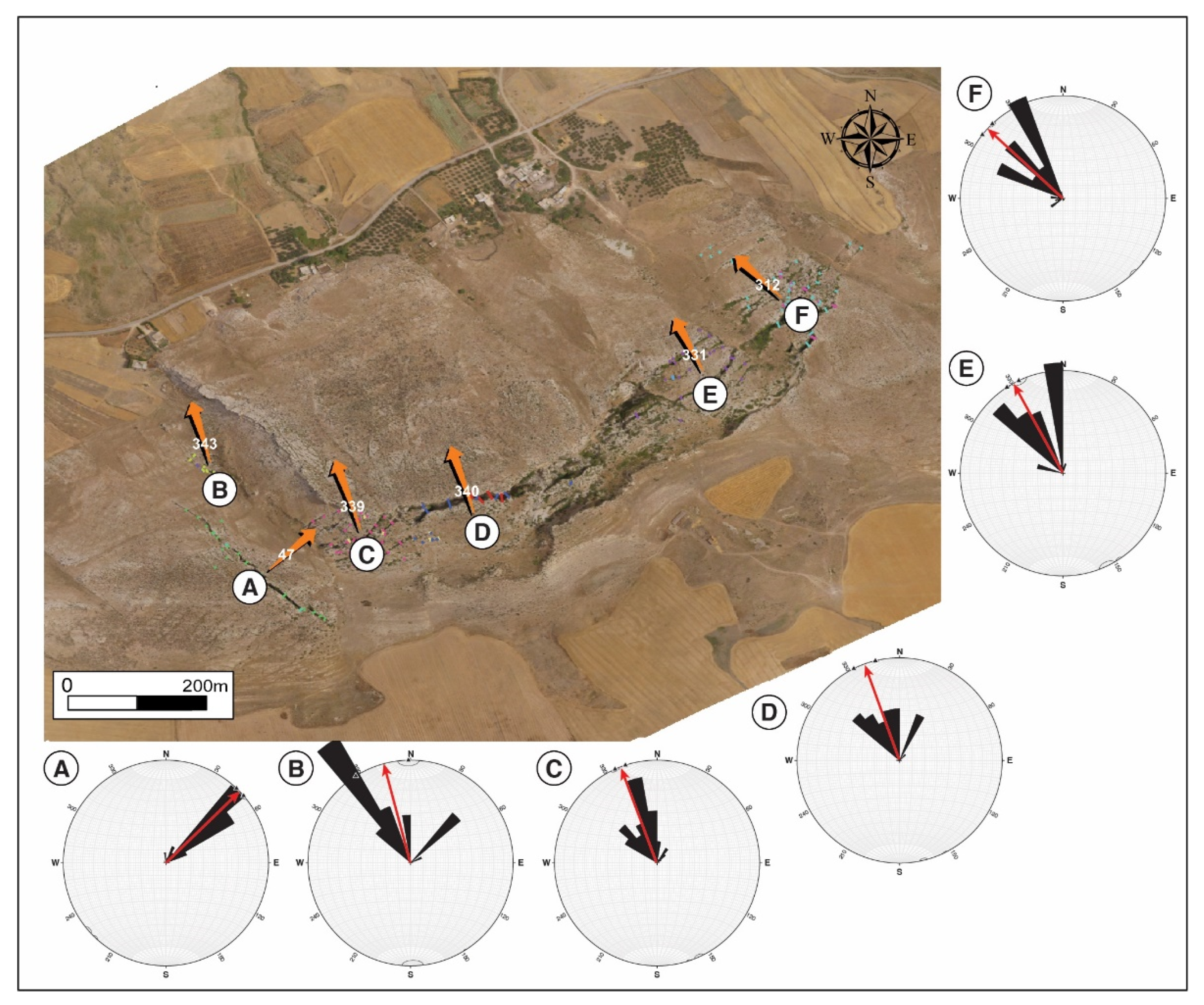
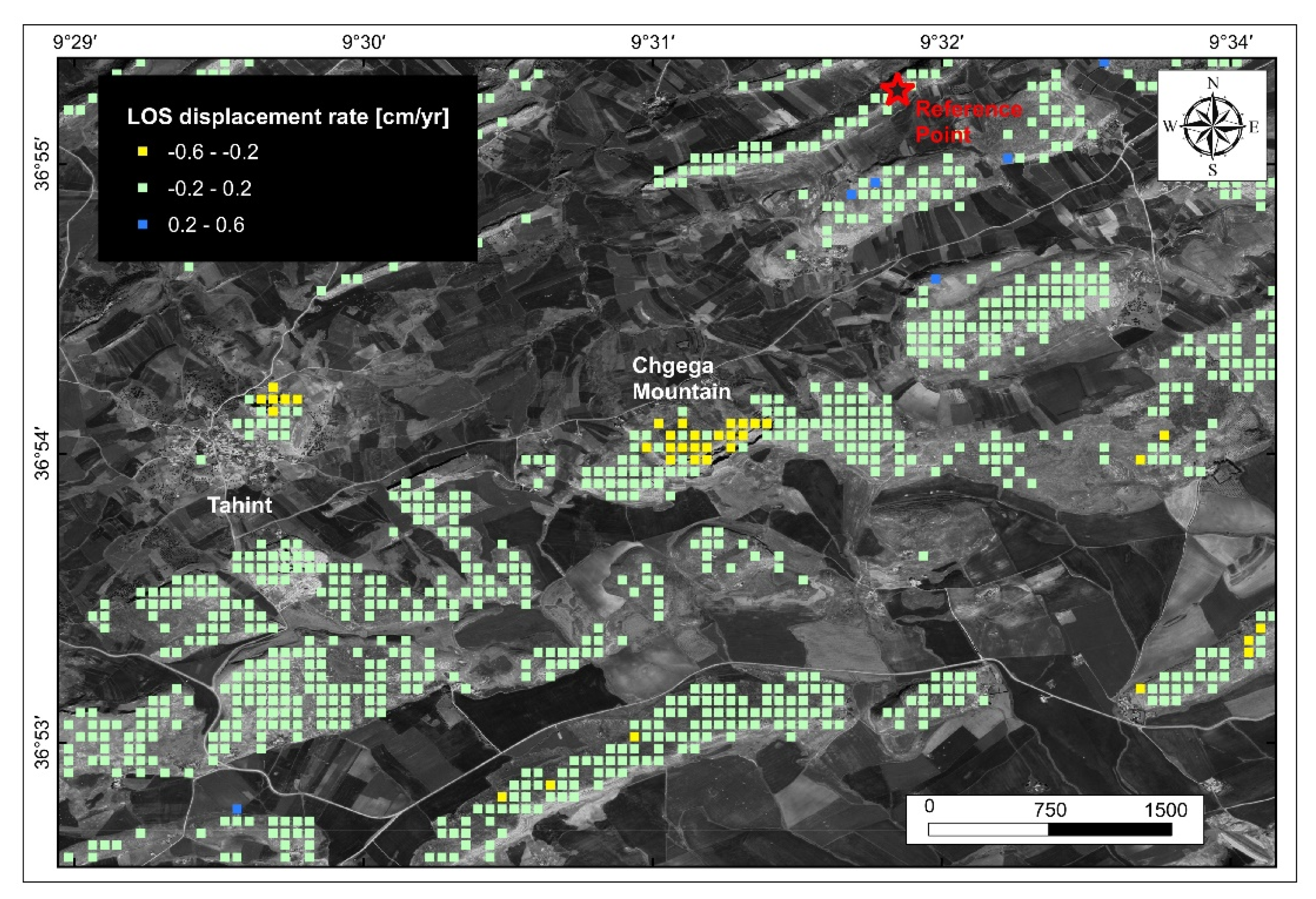
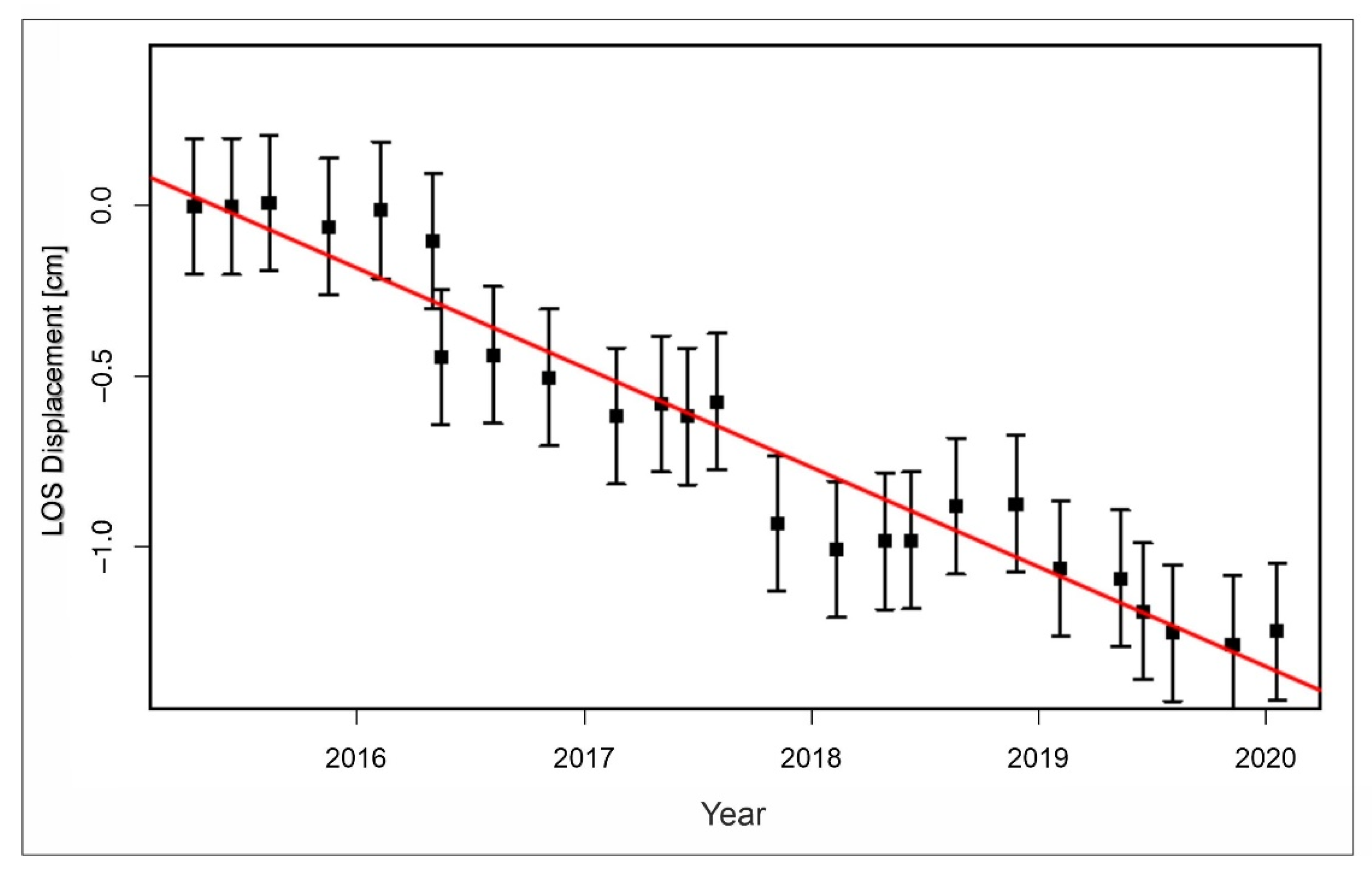
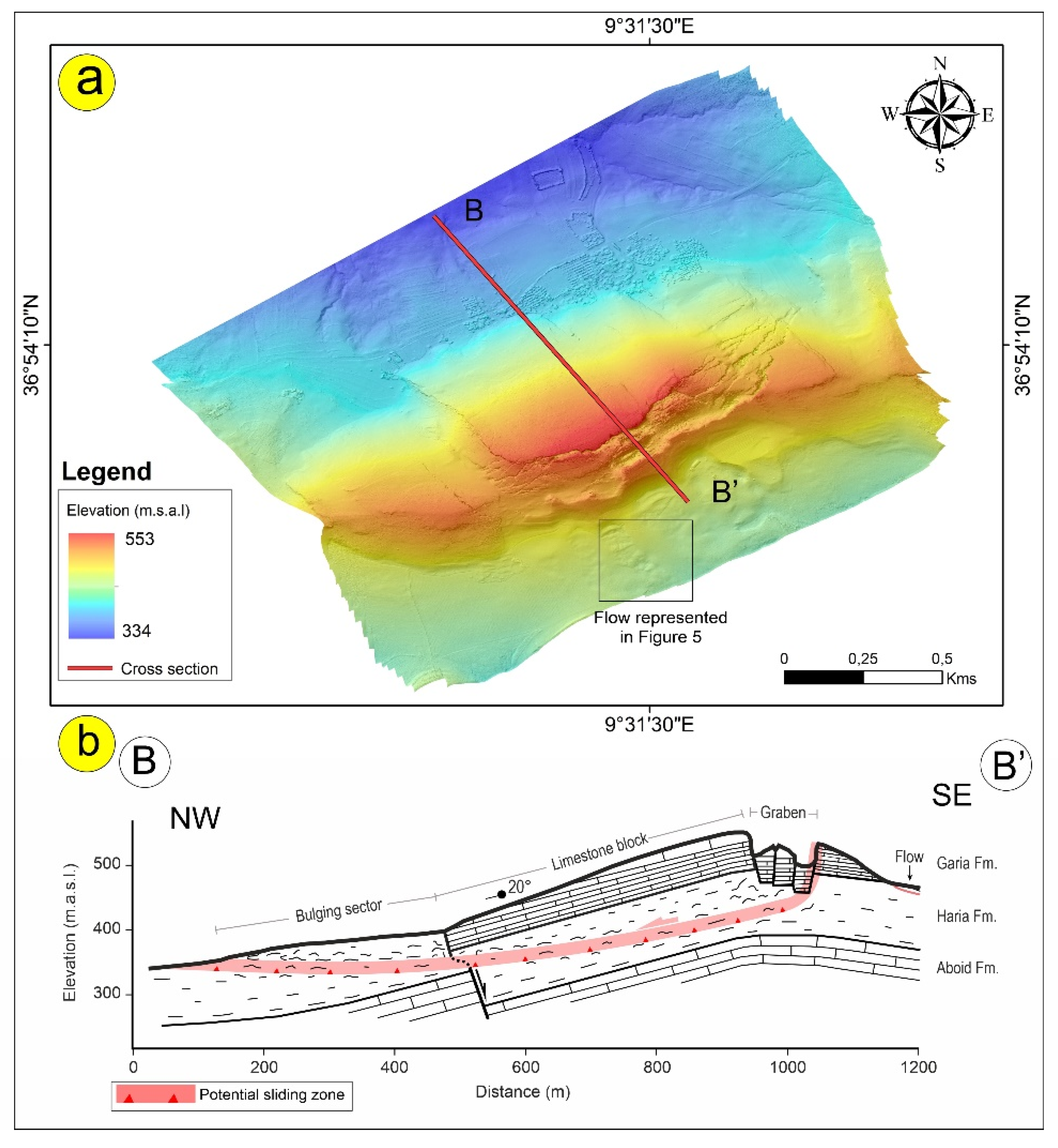
Publisher’s Note: MDPI stays neutral with regard to jurisdictional claims in published maps and institutional affiliations. |
© 2021 by the authors. Licensee MDPI, Basel, Switzerland. This article is an open access article distributed under the terms and conditions of the Creative Commons Attribution (CC BY) license (https://creativecommons.org/licenses/by/4.0/).
Share and Cite
Gaidi, S.; Galve, J.P.; Melki, F.; Ruano, P.; Reyes-Carmona, C.; Marzougui, W.; Devoto, S.; Pérez-Peña, J.V.; Azañón, J.M.; Chouaieb, H.; et al. Analysis of the Geological Controls and Kinematics of the Chgega Landslide (Mateur, Tunisia) Exploiting Photogrammetry and InSAR Technologies. Remote Sens. 2021, 13, 4048. https://doi.org/10.3390/rs13204048
Gaidi S, Galve JP, Melki F, Ruano P, Reyes-Carmona C, Marzougui W, Devoto S, Pérez-Peña JV, Azañón JM, Chouaieb H, et al. Analysis of the Geological Controls and Kinematics of the Chgega Landslide (Mateur, Tunisia) Exploiting Photogrammetry and InSAR Technologies. Remote Sensing. 2021; 13(20):4048. https://doi.org/10.3390/rs13204048
Chicago/Turabian StyleGaidi, Seifeddine, Jorge Pedro Galve, Fetheddine Melki, Patricia Ruano, Cristina Reyes-Carmona, Wissem Marzougui, Stefano Devoto, José Vicente Pérez-Peña, José Miguel Azañón, Haifa Chouaieb, and et al. 2021. "Analysis of the Geological Controls and Kinematics of the Chgega Landslide (Mateur, Tunisia) Exploiting Photogrammetry and InSAR Technologies" Remote Sensing 13, no. 20: 4048. https://doi.org/10.3390/rs13204048
APA StyleGaidi, S., Galve, J. P., Melki, F., Ruano, P., Reyes-Carmona, C., Marzougui, W., Devoto, S., Pérez-Peña, J. V., Azañón, J. M., Chouaieb, H., Zargouni, F., & Booth-Rea, G. (2021). Analysis of the Geological Controls and Kinematics of the Chgega Landslide (Mateur, Tunisia) Exploiting Photogrammetry and InSAR Technologies. Remote Sensing, 13(20), 4048. https://doi.org/10.3390/rs13204048







